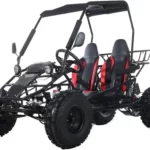A go-kart’s performance is highly dependent on its clutch system. One of the most common clutch systems used in go-karts is the centrifugal clutch. However, the clutch may need adjustments over time to ensure optimal performance. This article will provide a step-by-step guide on adjusting a centrifugal clutch, ensuring your go-kart experience remains exhilarating and safe.
| Key Takeaways |
|---|
| Understand the crucial role of a well-adjusted clutch for maintaining optimal go-kart performance and safety. |
| Follow our detailed step-by-step guide on adjusting a centrifugal clutch for smooth engagement and disengagement. |
| Learn about essential maintenance practices, inspection routines, and lubrication to prolong your clutch's lifespan and prevent issues. |
| Gain insights into common centrifugal clutch problems, troubleshooting techniques, and solutions to ensure your go-kart remains in top condition. |
Related Article: 10-Tooth Vs 12-Tooth Clutch: What Are The Differences?
The Importance of a Well-Adjusted Clutch
The clutch is crucial in transferring power from the engine to the wheels. A well-adjusted centrifugal clutch ensures smooth engagement and disengagement, allowing the go-kart to accelerate smoothly and maintain a consistent speed. A poorly adjusted clutch can lead to jerky acceleration, reduced top speed, and increased engine and drivetrain components wear.
Step-by-Step Guide to Adjusting a Centrifugal Clutch
1. Gather the Necessary Tools and Safety Equipment
Before getting started, make sure you have the following tools and equipment:
- Wrench set
- Screwdriver
- Work gloves
- Safety goggles
Also, ensure you work in a well-lit, spacious, and clean environment. If you’re unsure about any aspect of the process, consult a professional or an experienced go-kart mechanic.
2. Access the Clutch
Turn off the engine and let it cool down before working on the clutch. Remove any guards or covers that may obstruct access to the clutch. This may require removing bolts or screws, so keep track of them for reassembly later.
3. Inspect the Clutch Components
Inspect the clutch components for signs of wear or damage. Consider replacing the affected parts if you notice any issues, such as worn clutch shoes, broken springs, or damaged drums. For more information on the different types of clutches, check out our article on centrifugal clutch vs torque converter.
4. Adjust the Clutch Engagement
The springs’ tension determines the clutch engagement point. Tightening the springs will raise the engagement RPM while loosening them will lower the engagement RPM. To adjust the springs:
- Locate the springs on the clutch shoes.
- Depending on the desired engagement RPM, use a wrench or screwdriver to tighten or loosen the springs.
- Ensure that all springs are adjusted evenly for a balanced clutch operation.
5. Reassemble and Test
Once the adjustments are complete, reassemble the go-kart by reinstalling any guards or covers you removed earlier. Start the engine and test the go-kart’s performance, ensuring the clutch engages and disengages smoothly.
Additional Tips for Centrifugal Clutch Maintenance
To keep your go-kart’s centrifugal clutch in top condition, follow these maintenance tips:
- Regularly inspect the clutch components for wear and damage. Replace any worn or damaged parts as needed.
- Keep the clutch clean and free of dirt, debris, and grease.
- Lubricate the clutch bearings regularly to ensure smooth operation and reduce wear.
For more information on maintaining your go-kart, check out our article on how to maintain a go-kart.
Conclusion
Adjusting a centrifugal clutch on your go-kart is essential to maintaining its performance and ensuring a fun and safe driving experience. By following our step-by-step guide and maintenance tips, you’ll keep your go-kart running smoothly and extend the life of its clutch system.
For more information on go-karting, check out our other informative articles on various aspects of go-karting. Learn about the best go-kart brands and best go-kart engines to make an informed decision when upgrading or purchasing a new go-kart. To improve your driving skills, explore our article on go-kart cornering techniques and how to overtake in a go-kart.
If you’re new to go-karting or looking to introduce your children to the exciting world of karting, check out our guides on the best drift karts for kids, the best pedal go-karts for kids, and go-kart racing for kids.
For the more adventurous go-kart enthusiasts, we have articles on electric vs gas go-karts, how to make a go-kart faster, and how to build a go-kart without a welder.
Whether you’re a seasoned kart racer or a beginner just starting, our comprehensive collection of articles at GoKartLife will provide expert advice, tips, and guides to help you get the most out of your go-karting experience. Happy racing!
Frequently Asked Questions
If your go-kart is experiencing issues like sluggish acceleration, loss of power, or difficulty starting, it may indicate that the centrifugal clutch needs adjustment. A well-maintained clutch will ensure smooth and optimal performance for your go-kart.
The frequency of clutch adjustments depends on how often you use your go-kart and the specific model. Inspecting the clutch for wear and tear every few months or after every 20 hours of use is recommended. Adjust the clutch as needed if you notice any signs of damage or improper function.
Yes, you can replace a centrifugal clutch with a torque converter. Torque converters offer better performance and efficiency, especially for off-road go-karts.
Regular maintenance and proper lubrication are essential to extend the life of your centrifugal clutch. Ensure you clean the clutch components and apply the appropriate lubricant according to the manufacturer’s guidelines. Avoid aggressive driving habits, such as sudden acceleration or abrupt stops, which can cause unnecessary wear and tear on the clutch.
Some common issues with centrifugal clutches include excessive wear on the clutch shoes, a damaged or broken clutch spring, or improper alignment between the clutch and the engine. Regular maintenance and inspection of the clutch components can help identify and resolve these issues before they impact the performance of your go-kart.

Goran, an experienced go-kart racer, fuels GoKartLife.com with his passion and expertise. He offers valuable insights and tips for fellow enthusiasts, fostering the growth of the go-kart community. Join Goran at GoKartLife.com and immerse yourself in this exhilarating sport.
Last modified: December 11, 2024



